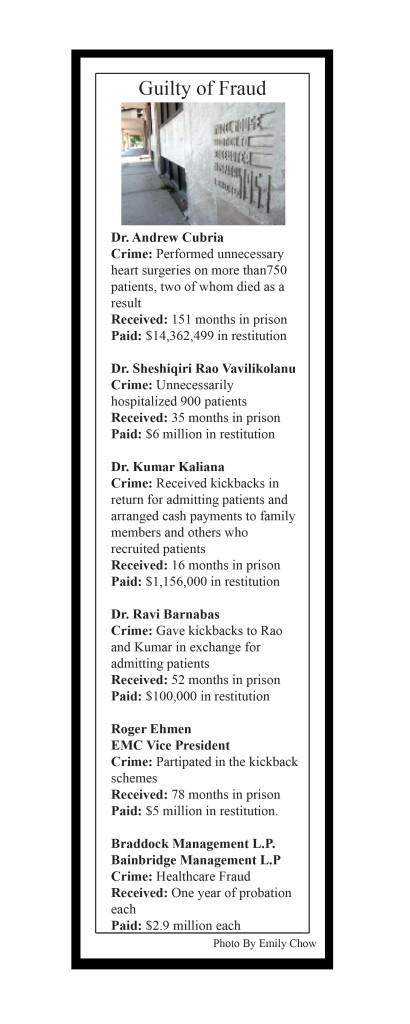This is a story I wrote for a journalism class in the Edgewater community of Chicago in 2010. The project profiles their now vacant medical center from its glory days to scandal, fraud, abandonment, and the movement to fix its current hazardous state.
The Edgewater Medical Center: From Glory to Decay
EDGEWATER, Ill. – The Edgewater Medical Center (EMC) is an abandoned complex of buildings at the corner of Ashland and Hollywood. The condemned buildings’ doors and windows are covered with plywood. The façades of the buildings are slowly falling apart, and scaffolding stands along the sidewalk to protect pedestrians.
Inside, the rooms look as if they were hurriedly vacated, with files and even autopsy photos left behind. The furniture, expensive medical equipment, even bottles of chemicals stand just as they were the day the hospital closed more than nine years ago.
Now decay has taken over the buildings, the copper floors have been stolen, and graffiti covers the walls, leaving the EMC a shell of its former self. But once upon a time, this hospital was a luxurious state-of-the-art facility run by a world-renowned doctor.
More of a Hotel Than a Hospital
The EMC was opened with a grand ceremony on January 6, 1929. The board that financed and ran the new hospital sent out formal invitations to prominent Chicago doctors and citizens and took out full-page advertisements in local newspapers to promote the celebration.
The building had solid bronze front doors and an entryway and lobby walled in marble. It was technologically advanced for its time with telephones, paging systems, an emergency lighting system, headphones for central radios in every room, and several X-ray and sterilizing machines. It had rubber floors to eliminate noise, except for operating room floors which were done entirely in copper.
The EMC also had luxuries like a rooftop solarium, a kitchen headed by a local restaurateur, a hydro-therapy room with the latest types of bath and massage equipment, and a physio-therapy department that specialized in light treatments. “One need not be ill to have treatments here,” said a newspaper article that covered the EMC’s grand opening.
Deluxe suites had handcrafted furniture in a choice of styles and solid mahogany doors, and there were even uniformed bellhops at the beck and call of any patient. “We are giving the patient the first consideration here. Rooms will have the luxury of a fine hotel at the price of an ordinary room,” said Dr. Maurice S. Mazel.
Dr. Mazel, a board member and resident doctor, helped found the hospital and steer it through the Great Depression. Mazel received worldwide recognition as a cardiac surgeon in the early 1950s for his invention of a form of open-heart surgery that was performed around the world for more than 12 years.
Expansions on the hospital were nearly constant, and six new buildings were erected between 1952 and 1973, including the addition that housed one of only three hyperbaric chambers in the Chicago area. Patients were sent from around the Midwest for inhalation therapy in the chamber.
During these expansions, the EMC faced its first public scandal. Mazel received kickbacks from the hospital’s industrial contracts, and in 1963, a jury found Mazel guilty of fraud and tax evasion. It would be the first fraud charge of many at the EMC.
Healthcare Fraud Changes the EMC
The hospital as recently as February 2001 was a 311-bed nonprofit facility where more than 30,000 patients received care each year, according to a profile filled out by the EMC that is currently on Hospital-Data.com. It was one of the largest employers on Chicago’s North Side until it was revealed that doctors had been recruiting patients in a massive healthcare fraud intended to save the hospital from bankruptcy.
On May 17, 2001, government investigators filed a 58-count indictment against hospital officials. “Patients were either misled as to the gravity of their medical condition or, in some cases, paid or coached to lie about their medical condition in order to justify hospital admissions,” said Gary Shapiro, the first assistant U.S. attorney in Chicago at the time, in a 2001 press conference.
Shapiro said the efforts to generate admissions focused on homeless people who needed food and a place to stay. “Key to the scheme was getting doctors to find vulnerable patients who were ‘promised that hospital services would cost them nothing,’” Shapiro said.
Four doctors confessed to fraud, among them Dr. Andrew Cubria, a cardiologist, who admitted to performing unnecessary angioplasties and heart catheterizations on more than 750 patients, two of whom died as a result, said the U.S. Department of Justice in a press release on the settlements.
Braddock Management L.P. and Bainbridge Management L.P., the two management firms that ran the EMC in those years, plead guilty to health care fraud and agreed to pay $2.9 million each to settle the lawsuits against them.
The fraud was not a surprise to many who worked at the hospital. Nancy Sullivan, a retired nurse, noticed that the kind of people frequenting the hospital changed as the fraud developed. “My husband and I would be walking the dog and we noticed there were more homeless people walking around, and that of course was who they were treating,” she said.
Even before the fraud was revealed, the EMC had developed a reputation for being dangerous. “We used to call it the butcher shop when we were growing up,” said Nancy.
Leading up to the closure, doctors who worked at the hospital even recommended to some patients that they not stay in such an unsafe atmosphere. “Even our doctor, he was on staff there, and our daughter broke her leg skiing, and he said get her out of there,” said Martin Sullivan, Nancy’s husband.
The hospital closed in December 2001 and filed for Chapter 11 bankruptcy in February 2002. Eva Brennan, a charge nurse in the intensive care unit was there the day it closed. “The day it was going to close was when we were told that it was closing. At 6 o’clock in the morning there was a loudspeaker that said there was an emergency meeting in the auditorium, and we are going to have a meeting with the board of directors. As of 7 o’clock, we are going to transfer all of the patients out, and we are going to be closed. That’s it,” said Brennan.
The Battle Continues
The fraud continued to cause problems for years to come. The EMC’s 401(k) plan had more than $1 million in assets and 293 plan participants as of 2002. The U.S. Department of Labor sued the EMC in 2004 to manage the center’s assets and disburse them to the participants who had been unable to access their accounts.
“My 401(k), I was able to take out right away. But the people who did not take it went to some kind of government suit,” said Brennan.
Meanwhile, Peter Rogan, the former chief executive of the bankrupt EMC, was charged in 2006 with perjury because of a trust he established in the Bahamas to hide the money that he received from Medicare and Medicaid.
Rogan also owes Dexia Credit Local, a French bank and one of 240 creditors for the EMC, more than $120 million from a separate civil case that showed he defrauded the bank into agreeing to guarantee bonds used to purchase the hospital from him in the mid-1990s.
Rogan disappeared before he was charged and lived in Vancouver from 2006 until 2008, when he was detained by the Canada Border Services. At that time, he was charged with obstructing the government’s efforts to collect $64 million in civil penalties.
A Danger to the Community
Since the building was abandoned, little has been done with it. Alderman Patrick O’Connor said that the Department of Public Health only did a 15-minute inspection of the entire complex in March 2009. “We know there’s asbestos. Is there medical waste? Are there radioactive materials?” said O’Connor.
Chris Swan, a member of West Edgewater Area Residents, said only minor safety precautions have been taken, such as the scaffolding. “They put the scaffolding up years ago, and it’s there for the protection of people,” Swan said.
The building has also been broken into multiple times, and the neighborhood installed lights and a security guard to deter intruders. “Maybe two or three months ago some people broke in there, took all the copper,” said Martin.
“They were saying you know that there were people going in, but we really don’t know much except some people were saying there’s drugs,” said Brennan.
“You’d see sort of suspicious mobs of teenagers roaming around. We had a bit of tagging,” said Sarah Ashley, a former resident of the area. “I talked to a couple neighbors and we were kind of concerned, but it didn’t pan out.”
Looking to the Future
Swan and many others in the community want to turn the lot into a park after the building is demolished. “A park could create a kind of town square feeling in the neighborhood and increase land values,” said Swan.
Others are not so sure. “I would probably like to have a park, but then I don’t know. If it’s going to be a park, it’ll be who will manage it is the problem. There will probably be a lot of homeless people sitting on the bench, sleeping,” said Brennan.
Pete Wilson, another Edgewater citizen, thinks a park is worth the fight it will take to accomplish it. “I think we’ve got a lot of good support. A lot of people are excited about it. We know it’s going to be an uphill battle, but I think it’s for a really good cause and I think this area really needs this,” said Wilson.

